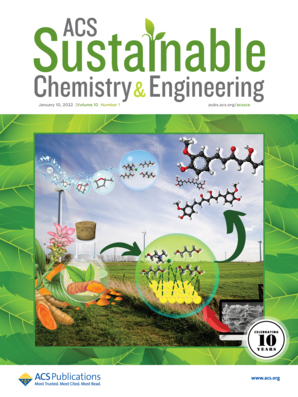Rational Design of a Cross-Linked Fully Biobased Flame Retardant for High-Efficiency Fire Safety and Multifunctional Enhancement in Polylactic Acid Composites
IF 7.3
1区 化学
Q1 CHEMISTRY, MULTIDISCIPLINARY
引用次数: 0
Abstract
Developing fully biobased green flame retardants to comprehensively enhance the performance of polylactic acid (PLA) has always been a significant challenge. In this study, a novel fully biobased flame retardant, CQEA, was successfully prepared by constructing a cross-linked network using three biobased materials: chitosan, phytic acid, and quercetin. Experimental results demonstrated that incorporating 6 wt % CQEA into PLA increased the limiting oxygen index (LOI) of the composite to 26.9%, successfully meeting the UL-94 V-0 testing standard. Moreover, the peak heat release rate (pHRR) was significantly reduced from 428 to 303 kW/m2, representing a decrease of 29.3%. Additionally, CQEA not only enhanced the flame retardancy of PLA but also promoted its crystallization process and endowed the material with excellent antibacterial properties, thereby comprehensively improving the functional characteristics of PLA. This study proposed an efficient and environmentally friendly method for modifying PLA, providing a new avenue for the development of high-performance, sustainable polymer materials. Through this approach, it is possible to address both environmental concerns and the need for advanced material functionalities simultaneously.

交联全生物基阻燃剂的合理设计,以提高聚乳酸复合材料的防火安全性和多功能
开发全面提高聚乳酸(PLA)性能的全生物基绿色阻燃剂一直是一个重大挑战。本研究以壳聚糖、植酸和槲皮素三种生物基材料为原料,构建交联网络,成功制备了新型全生物基阻燃剂CQEA。实验结果表明,加入6 wt % CQEA后,PLA的极限氧指数(LOI)达到26.9%,达到UL-94 V-0检测标准。峰值放热率(pHRR)从428 kW/m2显著降低到303 kW/m2,降低了29.3%。此外,CQEA不仅增强了PLA的阻燃性,还促进了PLA的结晶过程,赋予了材料优异的抗菌性能,从而全面改善了PLA的功能特性。本研究提出了一种高效、环保的聚乳酸改性方法,为高性能、可持续高分子材料的发展提供了新的途径。通过这种方法,可以同时解决环境问题和对先进材料功能的需求。
本文章由计算机程序翻译,如有差异,请以英文原文为准。
求助全文
约1分钟内获得全文
求助全文
来源期刊

ACS Sustainable Chemistry & Engineering
CHEMISTRY, MULTIDISCIPLINARY-ENGINEERING, CHEMICAL
CiteScore
13.80
自引率
4.80%
发文量
1470
审稿时长
1.7 months
期刊介绍:
ACS Sustainable Chemistry & Engineering is a prestigious weekly peer-reviewed scientific journal published by the American Chemical Society. Dedicated to advancing the principles of green chemistry and green engineering, it covers a wide array of research topics including green chemistry, green engineering, biomass, alternative energy, and life cycle assessment.
The journal welcomes submissions in various formats, including Letters, Articles, Features, and Perspectives (Reviews), that address the challenges of sustainability in the chemical enterprise and contribute to the advancement of sustainable practices. Join us in shaping the future of sustainable chemistry and engineering.
 求助内容:
求助内容: 应助结果提醒方式:
应助结果提醒方式:


